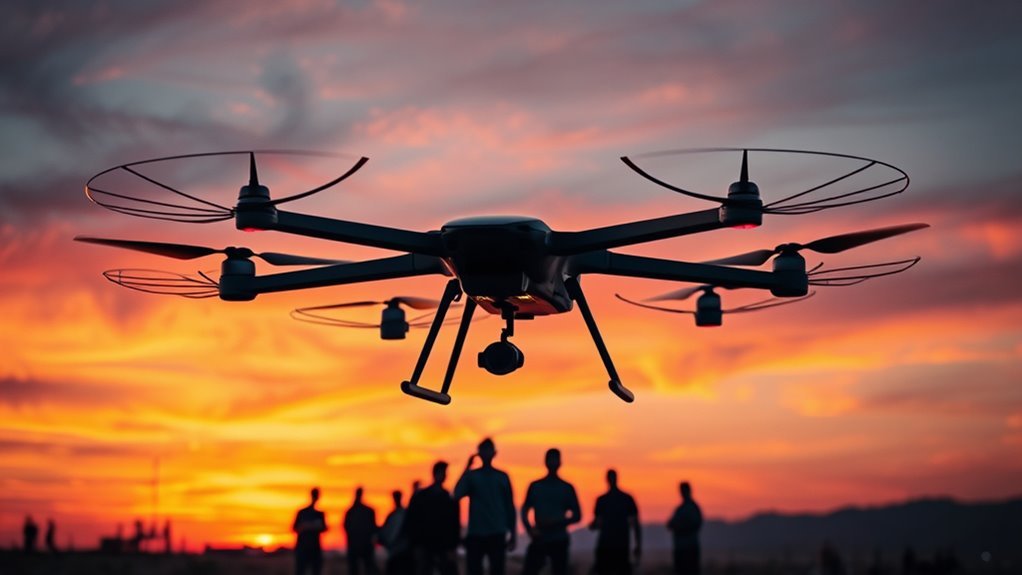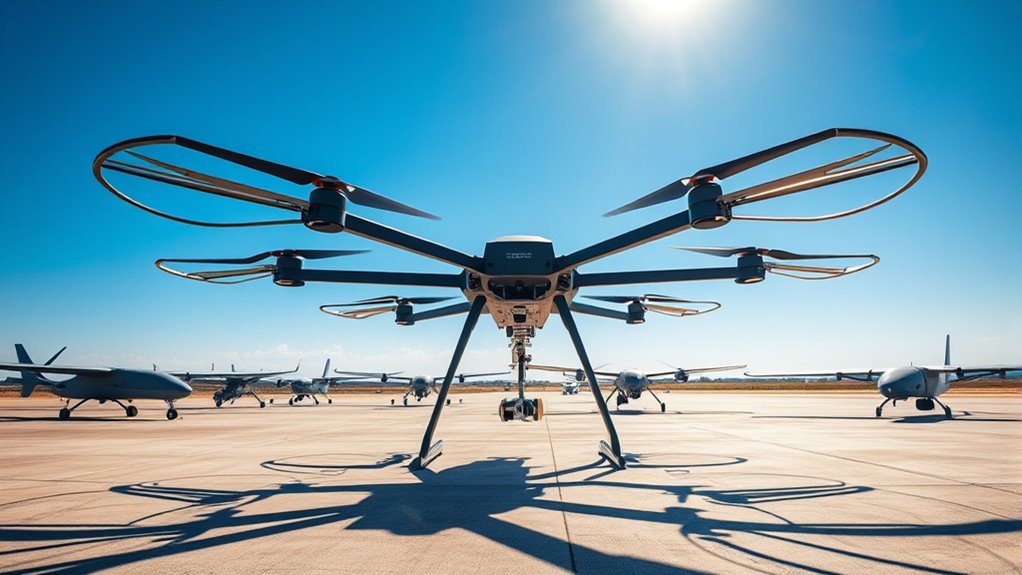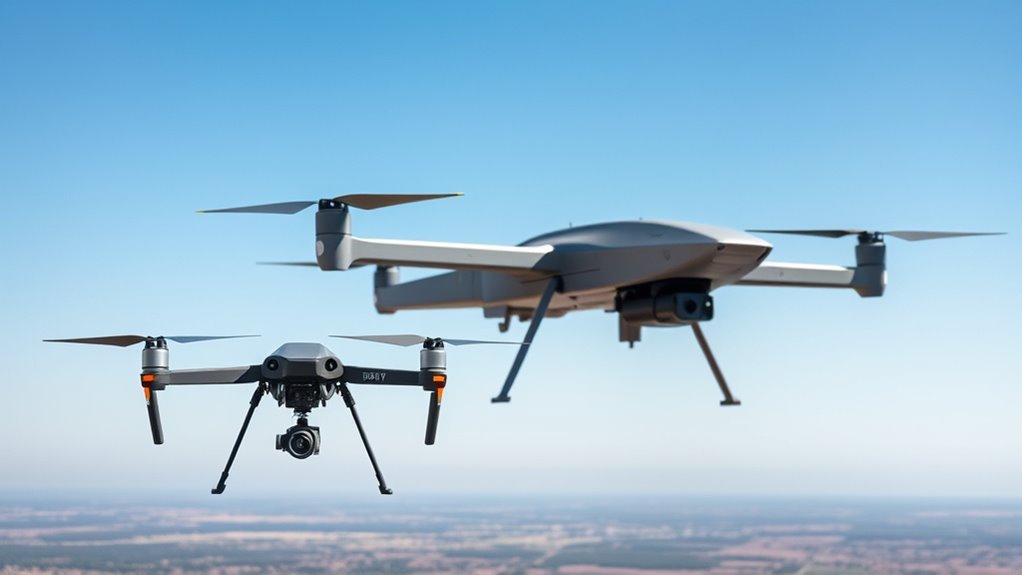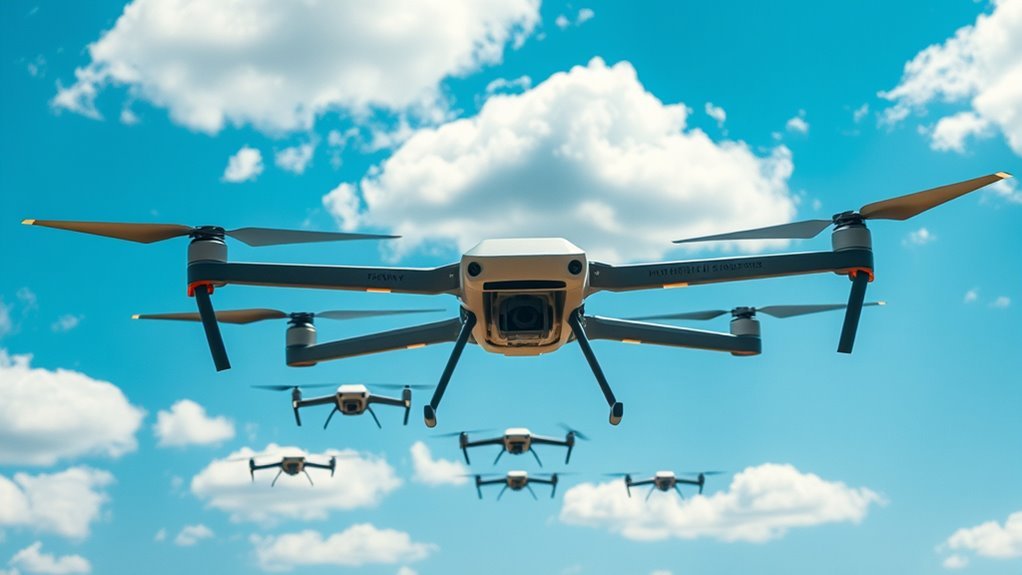Big drones typically range from 3 to 15 meters in wingspan and weigh between 25 kilograms to over a thousand kilograms, depending on their design and purpose. You’ll find fixed-wing models generally larger, especially in wingspan, while multi-rotor drones scale up with payload demands. Weight classifications vary, with military drones categorized as medium, large, or ultra-heavy. Size is influenced heavily by payload capacity, materials, and power sources, all critical factors shaping their operational capabilities and future development trends. Exploring these aspects reveals the full scope of big drone sizing.
Defining Big Drones: What Qualifies as “Big”?

When determining what makes a drone “big,” you need to contemplate specific metrics such as weight, wingspan, and payload capacity. Drone classifications rely heavily on established size standards, which vary across regulatory bodies but generally categorize drones above 25 kilograms as large. These size standards provide a framework to distinguish big drones from smaller models, focusing on operational capabilities and safety concerns. You’ll find that payload capacity often serves as a critical qualifier, as larger drones are engineered to carry substantial equipment or cargo. Understanding these classifications allows you to navigate the freedom of operating bigger drones responsibly while complying with legal boundaries. By analyzing these precise metrics, you can confidently identify what qualifies as a big drone within the technical parameters set by industry standards.
Wingspan and Dimensions of Large Drones

Beyond weight and payload, wingspan and overall dimensions play a significant role in categorizing large drones. When evaluating large drone types, you’ll notice wingspan measurements vary widely, impacting maneuverability and operational scope. Consider these key dimensional factors:
- Wingspan Range: Large drones often feature wingspans from 3 to 15 meters, with fixed-wing models typically occupying the higher end.
- Body Length and Width: These dimensions influence aerodynamic efficiency and payload capacity, usually spanning 2 to 10 meters.
- Height and Rotor Diameter: For multi-rotor large drones, rotor size directly affects lift capabilities and stability.
Understanding these metrics is essential if you want freedom in selecting drones optimized for extended flight durations, payload delivery, or surveillance. Precise wingspan measurements define operational envelopes, guiding you to the right large drone type for your mission.
Weight Categories of Heavy Drones

Since drone performance and regulatory requirements often hinge on weight, understanding the weight categories of heavy drones is essential for selecting the right model. Heavy drone specifications typically span from 25 kilograms to over 1,000 kilograms, with classifications varying by application. Military drone classifications often segment heavy drones into medium (25–150 kg), large (150–600 kg), and ultra-heavy (600+ kg) categories, each influencing payload capacity, endurance, and operational range. When you analyze these categories, you’ll see that weight directly affects flight dynamics, control systems, and compliance with airspace regulations. If you want freedom in drone operations, you must carefully evaluate how these weight thresholds impact performance limits and legal constraints. This knowledge guarantees you choose a heavy drone that balances power, maneuverability, and mission requirements efficiently.
Size Comparison Between Commercial and Military Drones
Weight categories provide a foundation for understanding drone capabilities, but size also plays a significant role in design and function. When comparing commercial and military drones, you’ll notice distinct differences driven by their intended applications.
- Commercial drones prioritize compactness for ease of deployment in varied environments, typically ranging from 0.5 to 5 meters in wingspan, optimizing for efficiency in delivery, surveying, and inspection tasks.
- Military drones, designed for extended endurance and payload capacity in complex missions, often exceed 10 meters, with some models reaching wingspans over 20 meters to support surveillance, strike, and reconnaissance operations.
- The disparity in size reflects the divergent demands of military applications versus commercial uses, balancing freedom in operation with specific performance criteria tailored to each sector’s unique objectives.
Influence of Payload on Drone Size
Although drone size is influenced by various factors, payload capacity remains a primary determinant. When you consider payload limitations, the drone’s structural design must adapt to accommodate weight without compromising flight efficiency or endurance. Larger payloads require reinforced frames, more powerful propulsion systems, and increased battery capacity, all contributing to overall size escalation. Your choices in drone configurations—such as fixed-wing versus multirotor—also affect how payload impacts dimensions. Fixed-wing drones can often carry heavier loads with less size increase due to aerodynamic efficiency, while multirotors tend to grow proportionally with payload demands. Understanding this relationship allows you to select or design drones optimized for your operational freedom, balancing payload needs against size constraints for maximal performance and maneuverability.
Size Variations in Agricultural Drones
When selecting agricultural drones, you’ll notice their frames range from compact to considerably large sizes. These variations directly impact payload capacity, affecting the types and amounts of equipment or materials the drone can carry. Understanding this relationship helps optimize drone choice for specific agricultural applications.
Small to Large Frames
Since agricultural drones must adapt to diverse tasks and environments, their frame sizes vary considerably—from compact models designed for precise crop monitoring to large, robust platforms capable of carrying heavy payloads and covering extensive fields efficiently. When choosing between small and large frames, consider these key aspects:
- Small drone advantages: Their compact size enhances maneuverability and reduces deployment time, ideal for localized inspections and detailed imaging.
- Large drone applications: Larger frames support extended flight durations and heavier equipment, making them suitable for broad-area surveillance and multispectral data collection.
- Operational flexibility: Frame size directly impacts portability and regulatory requirements, so balancing size with mission scope maximizes your operational freedom and efficiency.
Understanding these distinctions lets you select a drone frame that precisely fits your agricultural needs without unnecessary constraints.
Payload Capacity Differences
Frame size plays a notable role in determining an agricultural drone’s payload capacity, directly influencing the types and weights of sensors or equipment it can carry. When you consider payload efficiency, larger frames generally accommodate heavier and more diverse cargo types, such as multispectral cameras, sprayers, or seed dispensers. Smaller drones prioritize agility and endurance, limiting payload to lightweight sensors or basic monitoring tools. Conversely, big drones maximize payload efficiency by balancing frame strength with power output, enabling you to transport bulkier cargo without compromising flight time considerably. Understanding these payload capacity differences helps you select the right drone size for specific agricultural tasks, ensuring operational freedom and optimized performance tailored to your farm’s unique needs.
Technological Constraints Affecting Drone Size
You’ll find that power source limitations directly impact how large drones can be, as energy density restricts flight duration and payload capacity. Material strength plays a critical role, since structural components must balance weight and durability to maintain stability. Additionally, aerodynamic design challenges increase with size, requiring precise optimization to guarantee efficient lift and control.
Power Source Limitations
Although advances in battery technology have extended drone flight times, power source limitations remain a critical factor restricting drone size. When you consider scaling up, three main issues arise:
- Battery Efficiency: Current batteries offer limited charge-discharge cycles, impacting operational lifespan and reliability for larger drones.
- Energy Density: Even the best batteries have relatively low energy density, forcing drones to carry heavier power sources as size increases, which diminishes flight efficiency.
- Thermal Management: Bigger power units generate more heat, requiring complex cooling systems that add weight and reduce payload capacity.
Until breakthroughs in power storage and management emerge, these constraints will keep your drone’s size—and consequently, its freedom to roam—within tight bounds. Understanding these limits helps you optimize design without overextending current technology.
Material Strength Constraints
Beyond power source limitations, the physical integrity of a drone’s structure directly influences how large it can be built. You have to evaluate material durability and structural integrity, which govern the drone’s ability to withstand stresses without failure. As drones increase in size, materials must sustain greater loads, making strength-to-weight ratio critical. Choosing advanced composites or alloys enhances durability but raises costs and manufacturing complexity. Here’s a concise comparison:
| Material Type | Key Strength Property |
|---|---|
| Carbon Fiber | High tensile strength |
| Aluminum Alloy | Good fatigue resistance |
| Titanium Alloy | Excellent durability |
| Steel | Superior structural integrity |
| Polymer Composites | Lightweight, moderate strength |
Your freedom to scale drones hinges on balancing these materials’ constraints to maintain performance without compromising safety.
Aerodynamic Design Challenges
When scaling up drone size, aerodynamic design challenges become increasingly complex, directly impacting performance and efficiency. You must consider how to maintain ideal aerodynamic efficiency despite the increased surface area and structural complexity. Key factors include:
- Drag reduction: Larger drones face amplified drag forces that can severely limit range and maneuverability without precise design optimization.
- Lift generation: Ensuring sufficient lift while preventing structural stress requires balancing wing or rotor size with airflow dynamics.
- Stability and control: Bigger drones demand advanced control surfaces and algorithms to maintain stability amid turbulent airflow and variable conditions.
Future Trends in the Size of Large Drones
As advancements in materials and propulsion systems continue, you’ll notice that large drones are trending toward increased size and payload capacity without sacrificing efficiency. Future innovations, such as lightweight composites and hybrid-electric engines, enable these drones to meet expanding market demands for longer endurance and heavier cargo transport. You’ll see modular designs becoming prevalent, allowing customization to specific mission profiles while maintaining regulatory compliance. Additionally, autonomous guidance systems are evolving, reducing the need for onboard human intervention and enabling larger operational footprints. These trends reflect a shift toward maximizing operational freedom, balancing scale with agility. By understanding these technical trajectories, you can anticipate how large drone platforms will adapt to diverse applications, from industrial logistics to environmental monitoring, all while navigating evolving regulatory frameworks and airspace integration challenges.

